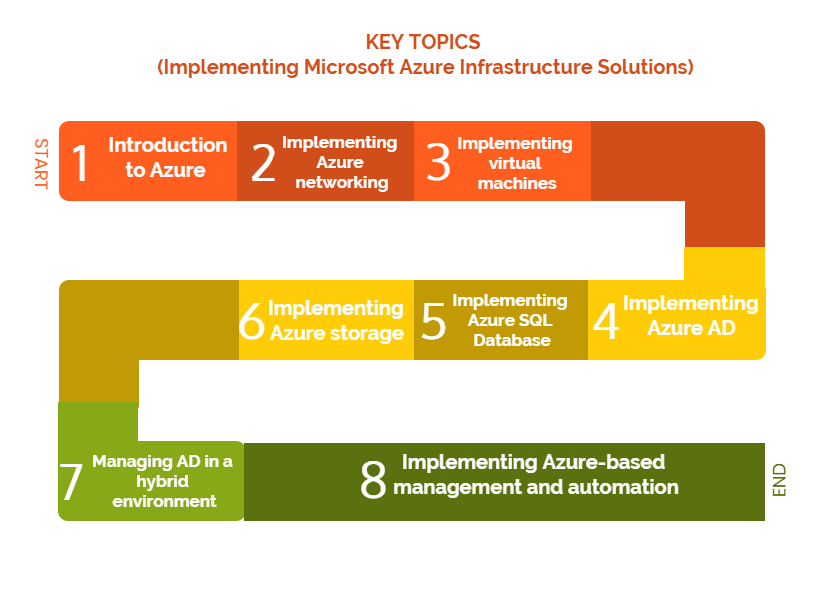Introduction to Azure
The module introduces delegates to the overview of cloud solutions and also explains the capabilities of portal used in managing Azure subscriptions and services.
Lessons
- Overview of Azure
- Use Azure portal
- Use Windows PowerShell
- Role of Azure Resource Manager
- Describe Azure management services
Lab: Organizing Microsoft Azure
- Apply the Azure portals
- Employ Azure PowerShell to manage services and subscriptions
- Use Azure Resource Manager via the Azure portal
Configuring and Managing Azure Networking
The module explains how to publish a service onto the internet and how virtual networking collaborates with web apps and virtual machines.
Lessons
- Understand the concept of Azure networking
- Setting up Azure virtual networks
- Installing connectivity of Azure virtual network
- Describe Azure classic networking
Lab: Implement Azure virtual networks by employing a deployment template
- Design a deployment template and create an Azure virtual network
- Use PowerShell
- Setting up virtual networks
- Validating virtual network connectivity
Configuring Virtual Machines
In this module, understand the fundamentals of Azure Virtual Machines and discuss various methods of their deployment and management.
Lessons
- Explain the main features of Azure Resource Manager virtual machines
- Deploy Azure Resource Manager virtual machines
- Understand the concept of classic virtual machines
- Designing templates for Azure Resource Manager
Lab: Planning Azure Resource Manager virtual machines in Azure
- Use Azure portal and Azure PowerShell to create virtual machines
- Validating creation of virtual machine
- Use Visual Studio and an Azure Resource Manager template
Managing virtual machines
The module provides the knowledge about management of virtual machines including the installation of virtual machines and virtual machines disks.
Lessons
- Learn how to set up virtual machines
- Install virtual machine disks
- Explain classic virtual machines
- Administer Azure virtual machines
Lab: Managing Azure virtual machines
- Execute desired state configuration (DSC)
- Installing availability
- Implementing storage space–based volumes
Executing Azure App Services
The module describes the selection part of App Service plan and guides how to use Azure PowerShell and Microsoft Visual Studio for deploying mobile and web apps. It also covers features of Azure WebJobs and Azure Traffic Manager.
Lessons
- Overview of App Service
- Installing web apps
- How to plan app deployment in App service
- Manage web apps and WebJobs
- Implementing mobile apps
- Explain the role of Traffic Manager
Lab: Implementing websites
- Identify an App Service plan and deployment method for apps
- Reviewing the performance of web apps
- Use Azure Traffic Manager to distribute requests between two or more app services
Creating and Executing Storage, Backup and Recovery Services
In this module, delegates will learn to plan and execute storage, backup, and recovery services. It also covers implementation of Azure Content Delivery Networks (CDNs) and Azure Site Recovery capabilities.
Lessons
- Choose appropriate Microsoft Azure Storage options
- Installing Azure Content Delivery Networks
- Explain Azure Site Recovery capabilities
- Implement Azure Site Recovery and Azure Backup
Lab: Planning and implementing Azure storage
- Enhance performance by implementing Azure content delivery network
- Manage Azure Storage
- Protecting data with Microsoft Azure Backup
Planning and Implementing Azure SQL Database
In this module, understand relational database services in Microsoft Azure and explains how to configure security for Azure SQL Database and monitor Azure SQL Database.
Lessons
- Recognize relational database services
- Configure and monitor Azure SQL Database
- Managing security of Azure SQL Database
- Maintaining business continuity
- Reviewing Azure SQL Database
Lab: Creating and executing Azure SQL Database
- Planning, securing and administering an Azure SQL Database
- Restoring a database
- Migration of Microsoft SQL Server database to Azure SQL Database
Executing PaaS cloud services
The module describes the planning, deployment and management phase of Azure Cloud Services.
Lessons
- Design and deploy PaaS cloud services
- Managing cloud services
Lab: Executing PaaS cloud services
- Install deployment slots and Remote Desktop Protocol (RDP)
- Reviewing cloud services
Implementing Azure Active Directory
The module introduces delegates to the functionality of Azure AD Premium, Azure AD tenants, and Azure Role-Based Access Control.
Lessons
- Planning and administering Azure AD tenants
- Understand Azure AD Premium
- Setting up resource access with Azure AD
Lab: Implementing Azure AD
- Managing Active AD
- Setting up multi-factor authentication
- Configure single sign-on (SSO) for cloud applications
- Install SSO from a Windows 10-based computer
Maintaining Active Directory in a hybrid environment
In this module, delegates will learn how to manage Active Directory and how to configure SSO between Azure AD and on-premises Active Directory.
Lessons
- Enhance an on-premises AD domain to Azure IaaS environment
- Executing federation
- Apply Azure AD Connect to implement directory synchronization
Lab: Implementing and managing Azure AD synchronization
- Executing directory synchronization
- Configure SSO by using federation
Implementing Azure-based management and automation
In this module, understand how to implement Azure based management and automation, Microsoft Operations Management Suite solutions by publishing runbooks and scheduling their execution.
Lessons
- Install Automation runbooks
- Execute Microsoft Operations Management Suite (OMS)
- Implement and administer Azure Automation
Lab: Implementing Automation
- Implement the core components of Azure Automation
- Configure Automation accounts






